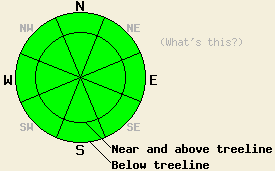
This Avalanche Advisory was published on January 10, 2012:

|
January 10, 2012 at 7:44 am |
|
LOW avalanche danger exists for all elevations and aspects. Normal caution is advised. |
|
|
|
Forecast Discussion:
A splitting trough off the California coast will bring increased mid and high level clouds to the forecast area today, but no precipitation. Air temperatures above around 6,500 feet are in the 30s across the forecast area this morning. Cloud cover will limit daytime warming with maximum day time air temperatures expected in the 30s and 40s for all elevations. Ridgetop winds shifted from east to southwest yesterday afternoon. Light to moderate speed southwest to west winds are forecast for today. High pressure will rebuild over the forecast area tomorrow. Sunny skies with cooler air temperatures mainly in the 30s above 7,000' and light east to northeast winds are forecast for Wednesday.
Recent observations from around the forecast area including those made yesterday at the top of the Pole Creek Drainage continue to show a fair bit of variability in the snowpack (pit profiles, photos, more info). Overall the snowpack is shallow with any significant amounts of snow limited to NW-N-NE-E aspects. All of these snow covered areas hold some form of surface crust, either supportable or breakable. There is significantly more snow along the Sierra Crest in the northern half to third of the forecast area than in other locations. Many areas saw a significant change in the existing snowpack following free water introduction associated with the December 28-29 warming and rain event. In these areas the now refrozen snowpack is a strong and stable mix of crusts and rounds. Faceting processes are at work to varying degrees below the rain crust in these areas. In other areas where little to no rain fell such as south of Barker Pass, on the east side of Lake Tahoe, and at high elevations, weak faceted snow remains underneath the existing surface crust. In these areas, the snowpack is very shallow, patchy, generally well anchored and therefore not a significant concern at this time. Isolated areas of fairly stable hard slab over faceted snow exist in a few areas on northerly aspects above 9,000' that were not scoured to bare ground during the December east wind events. Areas on SE-S-SW-W aspects are generally void of snow except for a few small shallow patches in heavily shaded areas.
Avalanche Concerns:
Avalanche concerns at this time are few. While some very isolated areas of a weak faceted layer with an overlying slab exist, triggering snowpack failure in these areas and creating an avalanche remains unlikely. The snowpack continues to change a little bit each day. Time will tell if the weak layers forming now will come to into play in the future or will be destroyed by future weather events before they are loaded by significant snowfall. Sliding falls on icy slopes leading to impact with exposed rocks and trees remains the biggest hazard to backcountry travelers.
The bottom line:
LOW avalanche danger exists for all elevations and aspects. Normal caution is advised.
Weather Observations from along the Sierra Crest between 8200 ft and 8800 ft:
| 0600 temperature: | 31 to 35 deg. F. |
| Max. temperature in the last 24 hours: | 49 to 51 deg. F. |
| Average wind direction during the last 24 hours: | East shifting to southwest |
| Average wind speed during the last 24 hours: | 15 mph |
| Maximum wind gust in the last 24 hours: | 31 mph |
| New snowfall in the last 24 hours: | O inches |
| Total snow depth: | 0 to 18 inches |
Two-Day Mountain Weather Forecast - Produced in partnership with the Reno NWS
For 7000-8000 ft: |
|||
| Tuesday: | Tuesday Night: | Wednesday: | |
| Weather: | Considerable high clouds, thickest in the afternoon. | Partly cloudy skies in the evening, then clearing. | Sunny skies. |
| Temperatures: | 40 to 45 deg. F. | 24 to 29 deg. F. | 36 to 41 deg. F. |
| Wind direction: | W | NE | E |
| Wind speed: | 10 to 15 mph with gusts to 25 mph in the morning, becoming light. | 10 to 20 mph with gusts to 30 mph. | 10 to 15 mph with gusts to 25 mph. |
| Expected snowfall: | O in. | O in. | O in. |
For 8000-9000 ft: |
|||
| Tuesday: | Tuesday Night: | Wednesday: | |
| Weather: | Considerable high clouds, thickest in the afternoon. | Partly cloudy skies in the evening, then clearing. | Sunny skies. |
| Temperatures: | 33 to 39 deg. F. | 20 to 27 deg. F. | 30 to 35 deg. F. |
| Wind direction: | W | NE shifting to E | E |
| Wind speed: | 15 to 25 mph with gusts to 35 mph. | 10 to 15 mph increasing to 20 to 25 mph with gusts to 40 mph after midnight. | 15 to 25 mph with gusts to 35 mph. |
| Expected snowfall: | O in. | O in. | O in. |

















